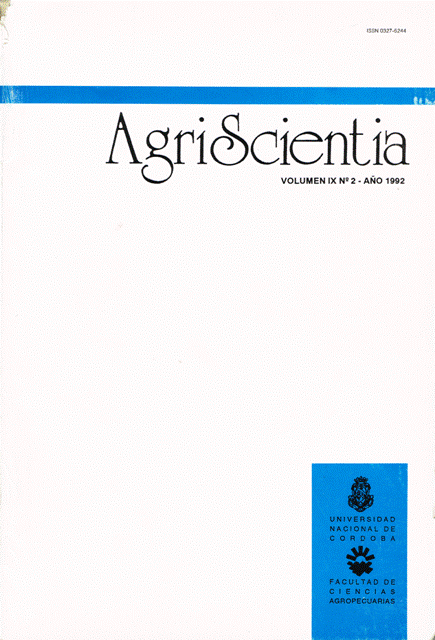Associations between phytophagous nematodes and weeds in Argentina
Main Article Content
Abstract
Weeds in general are directly responsible for serious damage in agriculture. Indirectly, they can be hosts and transmit a large number of phytopathogenous organisms. Among these, certain phytophagous nematodes are very important. They find numerous weed species that offer them the possibility of remaining in the soil, affecting its sanitary conditions and crop yields. For the first time in Argentina, a comprehensive study of the nematodes-weed relationships was made. Fourteen valid phytophagous nematode species and two non-identified ones were detected associated with weeds. Three nematode genera that have very dangerous species (Ditylenchus, Meloidogyne, and Nacobbus) are characterized by their association with many weeds. A large variety of weeds (forty-five valid species and nine non-identified ones) that have a wide distribution in the cultivated area of the country are associated with one or more phytophagous nematode species. Gramineae and Compositae are the most important families.
Article Details

This work is licensed under a Creative Commons Attribution-ShareAlike 4.0 International License.
How to Cite
References
Baayen, R. P. (1987). Responses related to lignification and intravascular periderm formation in carnations resistant to Fusarium wilt. Canadian Journal of Botany, 66, 784-792.
B'Chir, M. M., & Belkadhi, M. S. (1986). Nouvelles données sur les modifications histologiques induites par le complexe Fusarium solani-Tylenchulus semipenetrans au niveau des racines de porte-greffe de citrus. Med. Fac. Landbouww. Rijksuniv. Gent, 9 pp.
Cohn, E. (1972). Nematode diseases of citrus. In J. M. Webster (Ed.), Economic Nematology (pp. 215-244). Academic Press.
Costilla, M. A. (1969). Nematología agrícola. Serie Didáctica N.º 5, Facultad de Agronomía y Zootecnia, Universidad Nacional de Tucumán, 39 pp.
Chandel, Y. S., & Sharma, N. K. (1989). Interaction of Tylenchulus semipenetrans with Fusarium solani on citrus. Indian Journal of Nematology, 19, 21-24.
D'Ambrogio de Argüello, A. (1986). Manual de técnicas en histología vegetal. Ed. Hemisferio Sur, 81 pp.
Duncan, L. W., & Cohn, E. (1990). Nematodes parasites of citrus. In M. Luc, R. A. Sikora, & J. Bridge (Eds.), Plant parasitic nematodes in subtropical and tropical agriculture (pp. 321-346). C.A.B. International.
Fresa, R. (1943). La presencia del nematodo Tylenchulus semipenetrans Cobb en las raicillas de los citrus. Physis, 19, 348-354.
Gottlieb, Y., Cohn, E., & Spiegel-Roy, P. (1986). Biotypes of the citrus nematode (Tylenchulus semipenetrans Cobb) in Israel. Phytoparasitica, 14, 193-198.
Gutiérrez, R. O. (1974). El nematode de las raicillas de los citrus Tylenchulus semipenetrans en la República Argentina. Revista de Investigaciones Agrícolas, 1, 119-146.
Johansen, D. A. (1940). Plant microtechniques. McGraw-Hill, New York, XI + 523 pp.
Labuschange, N., Van Der Vegte, F. A., & Koetzé, M. (1989). Interaction between Fusarium solani and Tylenchulus semipenetrans on citrus roots. Phytophylactica, 21, 29-33.
López-Cristóbal, U. (1965). Nematodos fitófagos: Anguilulosis de las plantas cultivadas en Argentina. AGRO, 12, 31 pp.
Marchionatto, J. B. (1945). La "podredumbre de la raicilla" del naranjo. Corp. Frut. Arg., 127, 17-25.
Marchionatto, J. B. (1946). Nota relacionada con la etiología de la "podredumbre de la raicilla" del naranjo. Revista Argentina de Agronomía, 13, 96-100.
Marchionatto, J. B. (1947). La podredumbre de las raicillas de los citrus provocada por Tylenchulus semipenetrans. Min. Agric. Inst. de Sanidad Vegetal, Serie A, 3, 1-6.
Moreno, A. F. (1969). Nematodos hallados en raíz y tierra de plantas cítricas. CNIA, Inst. Patología Vegetal, Castelar. Hoja Informativa, 38.
Noling, J. W., & Duncan, L. W. (1988). Guidelines for managing citrus nematodes. Nematology Plant Protection Pointer, 27, 7 pp.
Schultz, E. F. (1945). La podredumbre de las raicillas de los citrus. Chacra, Buenos Aires, 15, 30-31.
Van Gundy, S. D., & Kirkpatrick, D. (1964). Nature of resistance in certain citrus rootstocks to citrus nematode. Phytopathology, 54, 419-427.
Van Gundy, S. D., & Meagher, J. W. (1977). Citrus nematode (Tylenchulus semipenetrans) problems worldwide. Proceedings of the International Society of Citriculture, 3, 823-826.





